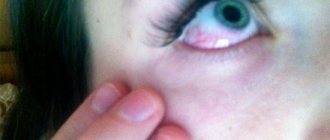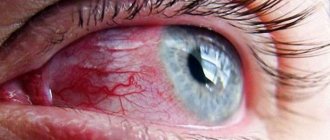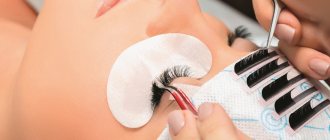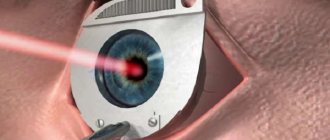Does this happen to everyone?
More often than not, children and adolescents have trouble seeing close up when they are first prescribed lenses. This occurs due to poor development of the intraocular muscles. When a child does not use lenses, the muscles do not work at full strength. When putting on correctors, the eyes cannot cope with the increased work.
But this problem can be eliminated if you do certain exercises. Time will pass, and the normal flow of vision will be restored, the muscles will get used to the new amount of work. You should consult a doctor if the problem does not resolve after a few weeks.
Adults may also not be able to see up close due to poor accommodation. The eye muscles do not work at full strength if lenses are missing. Therefore, a blurry image appears.
The problem of poor vision in lenses occurs in farsighted people. The power of the corrector confuses the nervous system, which is connected to the visual flow. It takes time to recover. Professionals recommend increasing the period of wearing lenses gradually. If the situation does not resolve within a month, then you need to consult a doctor.
What are the reasons?
In short, there are two main reasons for refusing to wear contact lenses: inconvenience during handling and the discomfort they cause.
The main thing that should be eliminated is eye irritation and dryness, but the question of how to do this still remains open. “Currently, there are a number of techniques that contactologists use, but, unfortunately, there are quite a lot of them, which indicates an insufficient understanding of the reasons that lead to eye irritation when wearing contact lenses,” Prof. shares his opinion. Fonn. – The problem of inconvenience during handling is simpler. Its solution may be to switch to the use of daily contact lenses that do not require maintenance, or to the prolonged wearing of silicone hydrogel contact lenses with a high Dk index, which provide the possibility of a kind of permanent vision correction and partially eliminate the care of contact lenses and frequent putting on/removal. Over the past five years, our research into high gas permeability silicone hydrogels has shown them to be safe to wear, and the vast majority of patients who participated in the studies were very satisfied with these contact lenses.”
Difficulties associated with wearing and caring for contact lenses lead many patients to refuse to wear contact lenses. A number of patients still experience difficulty handling elective contact lenses, especially when inserting them. “The most difficult is the patient who says they tried to wear elective contact lenses but didn't like them,” says contact lens specialist Peter Berginski, a fellow at Pacific University in Forest Grove, Oregon. – In most cases, these are patients who find it difficult to handle thin contact lenses. Nowadays, the choice of traditional lenses, of course, has become smaller, but it is still possible in this case to choose contact lenses with low or moderate moisture content that are easier to handle.”
While discomfort and inconvenience during handling are considered the main reasons for not wearing contact lenses, sometimes the problem lies in the initial incorrect selection of lenses, especially when it comes to a patient suffering from presbyopia or astigmatism.
“Patients often believe that discomfort, poor vision, and inconvenience are intractable problems, implying that if they were prescribed a pair of contact lenses and they don’t fit, there is no other alternative,” says Gary Gerber, a contact specialist in New Jersey. – I constantly remind my clients that during the first appointment and selection of contact lenses, the patient should be explained that if suddenly for some reason the contact lenses do not fit, or he sees poorly in them, or feels discomfort, this does not mean that he can’t wear contact lenses at all—it just means he can’t wear THESE contact lenses.”
“A number of contact lens wearers suffer from presbyopia, and although the development of bifocal contact lenses has greatly helped in correcting this, they still do not meet the needs of presbyopes,” said Dr. Gerber. “Contactologists need to learn how to use different types of bifocal contact lenses, monocular correction and corrective glasses to correct presbyopia.”
It is important to prescribe patients contact lenses that provide them with the same vision as their glasses. “About 45 percent of patients have at least 0.75 dioptres of astigmatism,” notes Prof. Andre. – If you look at the number of patients who wear toric contact lenses (which is fifteen percent of the total number of contact lens wearers), you will see that a significant portion of these people wear spherical contact lenses, when they need contact lenses that correct astigmatism. Eye fatigue occurs due to poor vision. With all the types of contact lenses we have - soft toric, toric elective replacement, rigid gas permeable contact lenses, there is no excuse for prescribing a spherical contact lens on an astigmatic eye.”
Possible reasons
It is worth understanding what causes discomfort when wearing CL.
External factors:
- incorrectly selected lenses in size;
- defective corrective lenses;
- lenses with poor shelf life;
- incorrectly selected solution.
Factors depending on the characteristics of the human body:
- Weakness of the eye muscles.
- Deposits on lenses from human tears. Human tears contain fat and protein. Silicone lenses become cloudy from fats, and hydrogel lenses from proteins.
- Taking hormonal drugs increases the rate of deposits.
- Dry eyes occur from an ophthalmological disease, diabetes mellitus, or from sitting at a computer for a long time.
Complications when wearing contact lenses
When wearing contact lenses, some complications may develop. Typically, complications are associated with violations of the rules for using lenses or caring for them. An infectious inflammatory process, intolerance to certain components of contact lens solutions, as well as corneal hypoxia (lack of oxygen in its tissue) may develop. Symptoms of such complications may resemble other eye diseases not associated with the use of lenses, so at the first sign you should definitely consult an ophthalmologist.
First of all, if any complication develops, it is necessary to stop using lenses, and then treat the symptoms of the disease. After this, the ophthalmologist will be able to decide whether it is possible for this patient to wear contact lenses in the future, or whether it is worth using another method of vision correction.
Red eye syndrome
Red eye syndrome is not a symptom of a specific eye disease; it can occur in various pathological conditions and have an allergic, infectious, mechanical, toxic, hypoxic nature. The cause of the condition will determine the severity of the symptoms. The most common symptoms include redness of the eyes, the appearance of pathological discharge, foreign body sensation, and discomfort.
Corneal hypoxia
The cornea of the eye receives oxygen from tear fluid, so any contact lenses to a certain extent disrupt the penetration of oxygen and lead to hypoxia. A state of acute hypoxia can occur if the patient forgets to remove lenses on time or leaves lenses that are not intended for long-term wear at night. Mild cases are manifested by corneal edema, a feeling of fog in the eyes, and blurred vision. In more severe cases, the death of corneal epithelial cells and their exfoliation develop. Visual acuity decreases, photophobia develops, and a feeling of discomfort appears.
With prolonged wearing of contact lenses, and even more so in the case of constant non-compliance with the wearing regime, the formation of microcysts is possible (in the depths of the epithelium, dead cells form microcysts and then migrate outward (and the germination of vessels into the corneal tissue - neovascularization. If new vessels are formed exclusively in the limbus area, vision is not impaired and there are no symptoms. However, when the vessels grow from the central area, vision can be significantly impaired. In order to prevent the progression of neovascularization, it is recommended to select thinner lenses and/or with better oxygen permeability.
Allergic, immune complications
The most common complication of contact lens wear is giant papillary conjunctivitis. This disease occurs in 2-3% of patients using lenses. The main reason for this condition is the accumulation of lipid and protein deposits on the surface of the lenses. This leads to mechanical irritation and an allergic reaction. Giant papillary conjunctivitis develops in the case of rare replacement of lenses, the use of weakly concentrated solutions for lenses, or the use of lenses for a longer period than recommended by the manufacturer.
This complication is manifested by redness of the eyes, as well as specific changes in the conjunctiva, which the ophthalmologist determines during examination with a slit lamp. Treatment includes the use of appropriate enzyme cleaning agents, lenses with more frequent scheduled replacement or those that are more resistant to deposit formation, and reduced lens wear time. Drug therapy may include antiallergic drugs and glucocorticosteroids.
Superior limbal keratoconjunctivitis is a condition that can also develop from contact lens wear; consists of an immune reaction, which is manifested by “red eye” syndrome, photophobia, thickening of the conjunctiva, decreased visual acuity, burning, itching. In case of such a complication, it is necessary to stop wearing lenses until the symptoms are completely relieved. It is also advisable to use peroxide lens care systems and switch to ZHPL.
Allergic conjunctivitis is a complication that develops as a hypersensitivity reaction to any component of lens solutions. This condition manifests itself as redness of the eyes and intense itching. It is necessary to stop using the solution to which the reaction occurred; sometimes local corticosteroids are prescribed.
Solutions intended for lens care can cause both allergic and toxic reactions. Symptoms are initially mild and nonspecific: the patient feels a foreign body, conjunctival hyperemia and hypertrophy of its papillae develop. The upper part of the limbus is more intensely hyperemic, punctate keratopathy is possible between the center of the cornea and the limbus (transparency decreases locally). Without adequate treatment, an opaque pannus of microcysts forms in its place (clouding of the surface layer of the cornea).
Sterile (non-infectious) keratitis is a complication when wearing contact lenses, which is characterized by the deposition of blood cells in the tissue of the cornea (its peripheral part). The cause of this condition is an immune reaction to bacterial toxins (microorganisms that are found on the back surface of the lenses). The infiltrates that form when you stop wearing lenses and use local corticosteroids resolve without permanent visual impairment.
Mechanical impact of lenses
When wearing contact lenses, mechanical damage to the cornea is possible. This occurs due to constant stress of epithelial cells during prolonged wearing of lenses, careless putting on and removal of lenses, foreign bodies getting under the edge of the lens, unevenness, and tears of lenses. Erosion forms in places of damage. This is manifested by lacrimation, decreased visual acuity, and photophobia. After stopping wearing lenses, erosions usually heal quickly. In case of infection, persistent turbidity, perforation, and ulcers may form.
Punctate superficial keratitis is a condition that is often reported in patients using contact correction. Its cause is usually the incorrect selection of lenses (too flat or steep fit), while superficial infiltrates form in different parts of the cornea. When using hard lenses, infiltrates are localized at 3 and 9 o'clock (according to the dial principle), on the periphery or in the center. The reason is a loose fit of the eyelids to the cornea in the area of the interpalpebral (between the eyelids) gap, instability of the tear film, and slow blinking aggravates the process. In the central region, infiltrates are formed when the cornea has a “steep” shape (this can be observed in the case of keratoconus), while the center of the cornea adheres to the lens more tightly than other parts. Infiltrates in the peripheral zone are formed when the cornea is flat when the lens rests on its edge. Regardless of location, infiltrates quickly resolve when the correct shape and size of lenses is selected. Sometimes topical corticosteroids are prescribed.
Superficial punctate keratitis occurs more frequently in patients who wear soft contact lenses. Lenses that cause severe eye dryness can lead to central and peripheral arcuate corneal opacities. Epithelial cracks may form in the upper part of the cornea without causing symptoms. In this case, it is necessary for lenses containing a higher percentage of moisture, or ZHPL.
Corneal deformation
Long-term use of contact lenses may result in gradual and unpredictable changes in the shape of the cornea. Most often, this complication occurs when using hard lenses, but it is also possible after using soft ones. After stopping the use of lenses, the shape of the cornea is restored within several months.
Chemical damage to the epithelium
Lens care solutions remaining on the lens surface after treatment can cause the development of “red eye” syndrome, lacrimation, photophobia, and pain. The hydrogen peroxide contained in peroxide systems, if not completely neutralized, can cause significant short-term visual impairment. In order to prevent such damage to the cornea, it is necessary to strictly follow all recommendations for the correct use of such lens cleaning systems.
Infectious keratitis
According to statistics for the United States, every year one in 2,500 patients who use daily contact lenses and one in 500 who wear continuous contact lenses develops infectious keratitis. The main reason is violation of the requirements for the care of contact lenses. Bacterial keratitis develops acutely, manifested by eye hyperemia, photophobia, pain, lacrimation, the appearance of purulent discharge, as well as decreased visual acuity. Treatment of this complication includes the use of antibacterial drugs, which, with timely initiation of therapy, can prevent complications.
Acanthamoeba is the most difficult to treat. This is a microorganism that is widespread in nature. Most often it gets into the eyes with contaminated tap water if the patient washes or stores lenses in it or does not remove them when swimming in water bodies. Sometimes treatment for such a complication lasts several months, using drugs such as neomycin, propamide, clotrimazole, miconazole, ketoconazole and others.
Dry eye syndrome
For patients using contact repair, tear film disruption is a common condition. This effect is more pronounced when using soft contact lenses. This is due to their large diameter, when the lens captures both the cornea and partly the tissue around it. The evacuation of microorganisms and foreign bodies (for example, dust particles) from under the lens slows down, the trophism of the underlying tissues decreases, and the chemical composition of tears is disrupted. This is manifested by redness of the eyes, sensation of a foreign body, dryness or lacrimation, pain, burning.
If such manifestations are present, it is advisable to switch to silicone hydrogel contact lenses or lenses made from the biocompatible material Proclear. Treatment for dry eye syndrome includes the use of moisturizing drops (artificial tears), which do not contain preservatives and can be used with lenses. It is recommended to include omega-3 acids in your diet, which reduce the evaporation of tears from the surface of the eye. In case of ineffectiveness, the lacrimal openings are closed with acrylic or silicone plugs.
Doctor - ophthalmologist of higher
category OMX No. 2
Fedoseeva M.A.
Visibility correction methods
It is necessary to understand why it is difficult to see close up in the CL.
Simple rules, if you follow them, will help you avoid problems with inconvenience:
- Select lenses and solutions with the help of a doctor.
- Change lenses on time.
- Remove correctors after the specified service life.
- Do not use solutions that have expired.
- Follow the rules for storing lenses.
- Do not replace the cleaning solution with water.
- Wash your hands thoroughly with a non-cream product and dry with a lint-free towel before putting on and removing lenses.
- Switch to glasses for viral diseases and allergies.
- Use moisturizing eye drops when staying in a room with heating devices for a long time. Rinse lenses with solution throughout the day.
- After putting on the correctors, pour the old solution out of the container. Rinse with disinfectant and dry the container.
- Change the container once a month.
- Do not allow cosmetics to come into contact with concealers.
- Rinse your lenses with the solution if you feel tired or uncomfortable.
- Eliminate the possibility of freezing.
If you do as the rules require, and you still have poor vision in the lenses, then you should urgently consult an ophthalmologist so as not to endanger your health.
Author's rating
Author of the article
Alexandrova O.M.
Articles written
2029
about the author
Was the article helpful?
Rate the material on a five-point scale!
( 1 ratings, average: 4.00 out of 5)
If you have any questions or want to share your opinion or experience, write a comment below.
Why do my eyes hurt when wearing lenses?
Soft contact lenses were invented only in the middle of the last century. In this short period of time, they have proven themselves to be an effective means for vision correction. Despite their positive characteristics, problems may arise when wearing them. For example, pain in the eyes some time after starting use.
So, why do your eyes hurt when wearing contact lenses? A lens is a foreign body in the eye, adjacent directly to the cornea, so it must be handled with care, following the rules of care and wearing time. If you neglect this, you may encounter unpleasant symptoms: your eyes will start to turn red and watery, your head will hurt, and your eyes will become dry. Here are some possible causes of eye discomfort when using contact lenses.
1. Allergic reaction. Often occurs due to protein deposits on the lenses or due to the solution in which they are stored - its components may not be suitable for your eyes. Failure to wear or replace lenses on time can also lead to allergies.
2. Incorrect selection. All types of lenses have clear parameters - their diameter, radius of curvature, optical power and others, which are selected for each patient. Ill-fitting lenses can cause eye pain due to mismatch. You cannot wear them; in this case, you should contact an ophthalmologist for replacement.
3. Dry eye. This symptom usually occurs if you spend a lot of time at the computer. Looking intensely at the monitor, a person blinks several times less often than usual, which leads to the drying out of the membrane and less production of tear fluid. In this case, it is recommended to use moisturizing drops at least once an hour and do special exercises for the eyes.
4. Insufficient oxygen supply to tissues (corneal hypoxia). Often appear when the wearing regime is violated - lenses are worn longer than prescribed or are not removed during sleep. Keeping the lens in the eye for a long time interferes with the flow of tear fluid to the cornea, and, as a result, its supply of oxygen. Remember, you need to remove your lenses on time, otherwise it can lead to vision deterioration.
There are cases of individual intolerance to lenses, then the doctor simply prescribes glasses.
What to do if you feel pain when wearing lenses? Of course, it's worth visiting an ophthalmologist. The doctor will identify the cause of the discomfort and do everything possible to correct it. But the patient himself must always remember that only compliance with all rules for operating optical products can guarantee comfort and safety.











